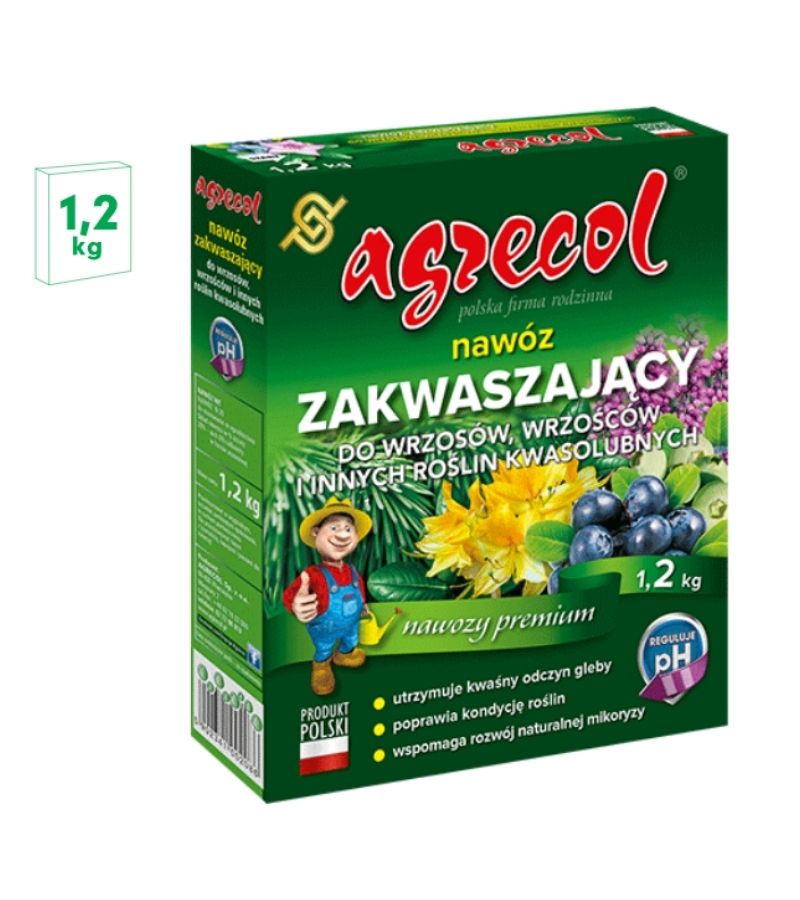Description
ACIDIFYING FERTILIZER FOR HEATHERS AND HEATHS ALSO OTHER ACIDAL PLANTS
An acidifying fertilizer for acidophilic plants is a granulated mineral fertilizer for heathers and heaths. Generally intended for the acidification of the substrate in the cultivation of acidophilic plants. Recommended for fertilizing all species of conifers, blueberries, rhododendrons, azaleas also other acidophilic plants. Additionally the appropriate form of nitrogen contained in the fertilizer stabilizes the acidity of the substrate.
- acidifies the substrate and keeps it acidic
- replenishes nitrogen deficiencies in acidophilic plants
- efficiency: 12 g is sufficient for 10 l of the intended substrate
- for planting, and for plants already growing 120 g per each meter – height or diameter of the plant
Contents
- EC fertilizer
- nitrogen (N) – 7%
- phosphorus (P2O5) – 21%
- potassium (K2O) – 7%
- Micronutrients: boron (B) 0.04%, copper (Cu) 0.1%, iron (Fe) 0.2%, manganese (Mn) 0.17%, molybdenum (Mo) 0.01%, zinc (Zn)0.035%
Acidophilic plants develop properly and grow only in the correct pH of the substrate. In high (neutral or alkaline) pH the substrate is unable to take up nutrients, which results in nutrient deficiencies. They are visible on plants in the form of chlorosis, discoloration, dieback, weakened growth, flowering or fruiting.
The acidifying fertilizer contains nitrogen in ammonium form, it acidifies the substrate, but also nourishes the plants for a long time, because it is not leached into the soil so quickly, but is retained in the sorption complex. Thanks to the acidification of the substrate, the plant absorbs the remaining macro- and micronutrients from the soil better and is properly nourished.
Application method
Use when planting plants or to regulate the reaction of plants already growing between March and August. It is best to fertilize once. If the reaction of the substrate has increased after some time, the fertilizer can be applied again after 3 months, by measuring half of the recommended dose.
Fertilizing plants during planting
Measure out the right amount of fertilizer: use 12 g of fertilizer for 10 liters of substrate.
Thoroughly mix the fertilizer with the substrate intended for planting plants.
After planting the plants, water the substrate with plenty of water.
Fertilizing plants that are already growing
Measure out the correct amount of fertilizer: 120 g of fertilizer per 1 m of height / diameter of the plant.
Sprinkle the fertilizer evenly around the plant and mix it with the topsoil as much as possible.
After applying fertilizer, water the plant abundantly.
1 handful is about 30 – 40 g of fertilizer.
Packaging: 1.2 kg
If you’re unsure about this product, then feel free to contact our team. We’ll be glad to assist you, explain how the product works, also recommend other suitable options for you. You can also contact with us on our fan page on Facebook – Garden Centre Margaret Mayar.
NAWÓZ ZAKWASZAJĄCY DO WRZOSÓW, WRZOSÓW I INNYCH ROŚLIN KWASOLUBNYCH
֍
– zakwasza podłoże i utrzymuje je w stanie kwaśnym
– uzupełnia niedobory azotu u roślin kwasolubnych
– wydajność: 12 g wystarcza na 10 l przeznaczonego podłoża
do sadzenia, a dla roślin już rosnących 120 g na każdy metr – wysokość lub średnicę rośliny
֍
Zawartość
nawóz WE
azot (N) – 7%
fosfor (P2O5) – 21%
potas (K2O) – 7%
֍
Mikroelementy:
bor (B) 0,04%, miedź (Cu) 0,1%, żelazo (Fe) 0,2%, mangan (Mn) 0,17%, molibden (Mo) 0,01%, cynk (Zn) 0,035 %
֍
Nawóz zakwaszający do wrzosów, wrzosowisk i innych roślin kwasolubnych to nawóz mineralny granulowany. Przeznaczony do zakwaszania podłoża w uprawie roślin kwasolubnych. Polecany do nawożenia wszystkich gatunków drzew iglastych, borówek, rododendronów, azalii i innych roślin kwasolubnych. Odpowiednia forma azotu zawarta w nawozie stabilizuje kwasowość podłoża.
֍
Acidophilic plants develop properly and grow only in the correct pH of the substrate. In high (neutral or alkaline) pH the substrate is unable to take up nutrients, which results in nutrient deficiencies. They are visible on plants in the form of chlorosis, discoloration, dieback, weakened growth, flowering or fruiting. The acidifying fertilizer contains nitrogen in ammonium form, it acidifies the substrate, but also nourishes the plants for a long time, because it is not leached into the soil so quickly, but is retained in the sorption complex. Thanks to the acidification of the substrate, the plant absorbs the remaining macro- and micronutrients from the soil better and is properly nourished.
֍
Application method
Use when planting plants or to regulate the reaction of plants already growing between March and August. It is best to fertilize once. If the reaction of the substrate has increased after some time, the fertilizer can be applied again after 3 months, by measuring half of the recommended dose.
֍
Fertilizing plants during planting
֍
Measure out the right amount of fertilizer: use 12 g of fertilizer for 10 liters of substrate.
Thoroughly mix the fertilizer with the substrate intended for planting plants.
After planting the plants, water the substrate with plenty of water.
Fertilizing plants that are already growing
֍
Measure out the correct amount of fertilizer: 120 g of fertilizer per 1 m of height / diameter of the plant.
Sprinkle the fertilizer evenly around the plant and mix it with the topsoil as much as possible.
Po zastosowaniu nawozu obficie podlewamy roślinę.
֍
1 garść to około 30 – 40 g nawozu.
֍
Opakowanie: 1,2 kg
INFORMATION
I am a seller but also a buyer, and I know how important the colors of the products you use for your projects are. Therefore, be aware that the colors of the products in the pictures may slightly differ from reality. It depends on the model, resolution and individual settings of your monitor. If you have concerns, it is always better to make sure and ask the seller about the details of the product before buying.





























